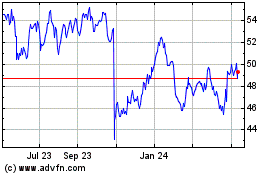By Matthew Dalton and Joseph Walker
PARIS -- A laboratory mistake has set back development of Sanofi
SA and GlaxoSmithKline PLC's Covid-19 vaccine, delaying potential
authorization by several months and complicating plans in the U.S.
and Europe to quickly inoculate swaths of their populations next
year.
Volunteers were accidentally given lower doses than intended in
initial clinical trials due to a miscalculation in the
manufacturing process, said Thomas Triomphe, Sanofi's executive
vice president for vaccines.
Sanofi scientists, he said, will have to reformulate the vaccine
to fix the problem with the goal of restarting clinical trials in
February, and potentially securing regulatory authorizations in the
fourth quarter of next year.
"It's a sad setback," Mr. Triomphe said in an interview. He
estimated a delay of four months to five months. But "we prefer to
take a step back, let the science work and come back with a product
that is very efficacious in addition to being safe....You don't
want to do compromises there."
U.S. and European public-health officials had high hopes that
the vaccine could be developed in time to start distributing it to
patients next year, a key part of their strategies to maximize
vaccine supply.
Sanofi and Glaxo previously aimed for regulatory authorizations
in the first half of 2021, but on Friday the companies pushed back
that timeline to the fourth quarter.
The vaccine constitutes 10% of total global coronavirus vaccine
doses that were expected from Western pharmaceutical companies next
year, according to U.S. investment bank Jefferies Group.
European and U.S. health authorities have said they ordered more
vaccines than their countries needed in the event some candidates
failed.
Sanofi and GSK received $2.1 billion from Operation Warp Speed,
the U.S. government's coronavirus vaccine program, to accelerate
the development and distribution of the vaccine -- the biggest
grant handed out by the U.S. program.
That deal called for the companies to supply the U.S. with 100
million doses and gave the government an option to order an
additional 500 million. The European Union ordered 300 million
doses, and the U.K. another 60 million.
Sanofi and Glaxo are two of the largest vaccine manufacturers in
the world by revenue. Though usually fierce rivals, they teamed up
this year in an unusual collaboration to jointly develop a vaccine,
betting that by combining their scientific expertise and global
operations reach they could move faster than by working alone.
Their vaccine combines a Sanofi-owned antigen -- a protein from
the coronavirus that triggers immunity -- and a Glaxo-owned
adjuvant, a molecule used in some vaccines to enhance the immune
response
Friday's setback highlights the high-wire act of vaccine
development in a pandemic, where even relatively mundane lab
mishaps can have global consequences for public health.
"This shows what we know, that it is not always easy to develop
a new vaccine to the point of being used to prevent the disease,"
said Stephen Evans, a professor of pharmacoepidemiology at the
London School of Hygiene & Tropical Medicine. "It is possible
that adjustment of doses and constituents of the vaccine could
improve responses in the elderly, but again, that is not
guaranteed."
Mr. Triomphe said that the mistake occurred because of faulty
lab materials, called reagents, that scientists were using to
measure the potency of their antigen.
Sanofi used two different reagents made by separate
manufacturers, but both wound up providing inaccurate measurements,
Mr. Triomphe said.
"These reagents were not of high-enough quality or pure enough,"
said Mr. Triomphe. "The good news is that we can fix that."
Mr. Triomphe declined to name the manufacturers that produced
the reagents.
The companies said that despite the dosing error, the vaccine
showed encouraging results in volunteers age 18 years to 49 years.
Yet it produced a weak immune response in people older than 50
years, a key demographic because they are more vulnerable to
Covid-19.
Sanofi's reagent mishap is the second laboratory snafu in recent
months to raise questions about the prospects of a leading vaccine
candidate.
In November, AstraZeneca PLC and the University of Oxford said
that a manufacturing error led to some patients receiving a
lower-than-intended vaccine dose in clinical trials. In that case,
the partners said the mistake may have been a happy accident
because the lower dose showed greater effectiveness, though some
experts have questioned whether the result will hold up after
further testing.
One risk of the kind of vaccine technology used by Sanofi-GSK is
that it was known going into the trial to produce weaker immune
responses in older patients, said Penny Ward, visiting professor in
Pharmaceutical Medicine at King's College London.
France was planning to begin its vaccination campaign this
winter with the compound produced by Pfizer Inc. and BioNTech SE,
the first coronavirus vaccine to be approved by regulators in the
West, targeting nursing-home residents. France was planning to use
the Sanofi-GSK vaccine as it starts inoculating the general public
in the spring.
The Sanofi-Glaxo vaccine was expected to help ease the
logistical challenges of mass vaccination since it can be stored at
nonfreezing temperatures, unlike the Pfizer-BioNTech vaccine, which
requires costly ultracold storage facilities.
Write to Matthew Dalton at Matthew.Dalton@wsj.com and Joseph
Walker at joseph.walker@wsj.com
(END) Dow Jones Newswires
December 11, 2020 14:48 ET (19:48 GMT)
Copyright (c) 2020 Dow Jones & Company, Inc.
Sanofi (NASDAQ:SNY)
Historical Stock Chart
From Mar 2024 to Apr 2024

Sanofi (NASDAQ:SNY)
Historical Stock Chart
From Apr 2023 to Apr 2024
